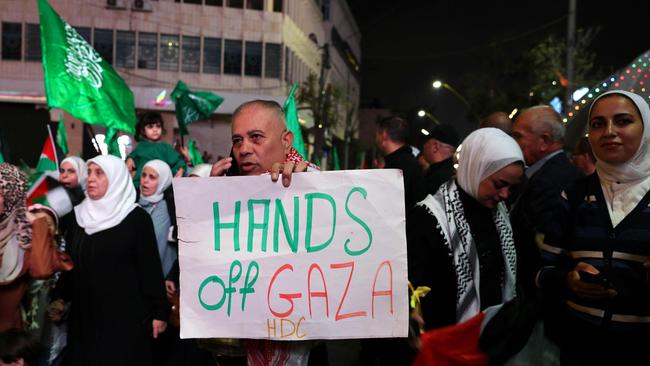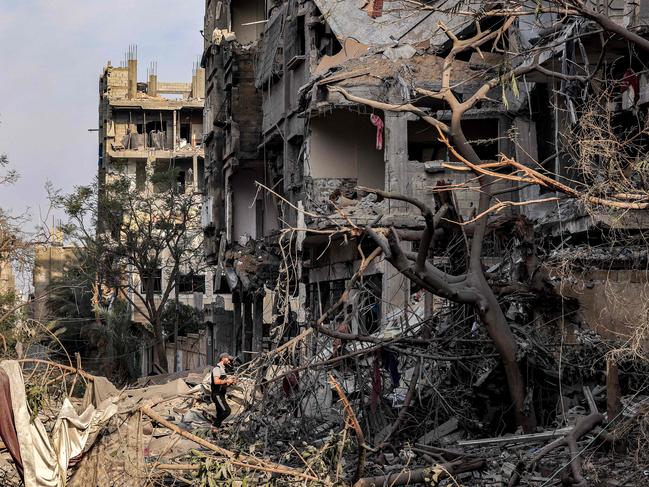Fears of ‘all-out war’ in Middle East as Israel conflict escalates
Fears of the Israel-Hamas war escalating have soared with real concern it could extend across the Middle East under Iran’s frightening new “resistance”.
Fears of the Israel-Hamas war escalating have soared with missiles and mortars being fired from both Lebanese and Syrian territory. And it could extend across the Middle East under Iran’s new “Axis of Resistance”.
The clashes along Israel’s northern border are yet to approach the scale of fighting around Palestine’s Gaza Strip in the south. But it has awoken memories of a bloody battle in 2006 that killed 1100 Lebanese and 165 Israelis, and worse – when Israel invaded Lebanon and laid siege to Beirut in 1982.
Palestinian Islamic Jihad fighters crossed the Lebanon border into Israel on Saturday to take part in the assault that caught Israel’s government and military off-guard. Since then, rocket and artillery clashes have involved the Shia Islamic extremist group Hezbollah in Lebanon and Syria.
“With the goal of bogging down the Israelis from all sides, Hamas has called for Palestinians in the West Bank to confront Israeli soldiers deployed there directly,” international security think-tank The Soufan Centre notes.
The West Bank comes under the umbrella of Hezbollah. Any significant Israeli military action in this occupied territory will likely trigger a response involving Hezbollah forces in Lebanon.
And that would present Israel with a two-front war.
“Waging major air and ground offensives in Gaza and Lebanon simultaneously would be a tough call for the Israeli government,” says Atlantic Council analyst Nicholas Blanford. Air power alone would not be enough to hold back any assault, he explains. Israel would need to deploy a significant ground force to push Hezbollah fighters deep back into Lebanon. And that would likely trigger widespread retaliation.
“A war with Hezbollah would turn regional with the Syria front opening up and the possibility of attacks from Iraq, Yemen, and even Iran,” he adds.

All eyes on Hezbollah
The Islamic religion is bitterly divided between Shia and Sunni dogmas. Iran’s Ayatollah Ali Khamenei is considered Shia’s supreme leader. Sunni doctrine puts authority in the hands of regional Grand Imams.
Hamas, the organisation behind the weekend’s surprise attack on Israel, is Sunni Islamist.
Hezbollah is Shia Islamist.
How willing the two factions are to join forces over Gaza is yet to be seen.
But Washington is sufficiently concerned to deploy a nuclear-powered aircraft carrier to the Eastern Mediterranean as an open warning for Iran and Hezbollah not to get involved.
“Let me be clear, we did not move the carrier for Hamas,” states US Secretary of Defense Lloyd Austin. “We moved the carrier to send a clear message of deterrence to other states or nonstate actors that might seek to widen this war.”

The effectiveness of this deterrence is yet to be determined.
“Iran’s proxies refused to flinch, with Iranian-backed Shia militias in Iraq and the Houthi movement in Yemen both threatening to target US interests with missiles and drones if the United States intervenes,” the Soufan Centre notes. “The so-called “axis of resistance,” led by Iran, remains intent on setting its own red lines, which, if crossed, would trigger escalation that would almost certainly drag the entire region into conflict.”
A Hezbollah spokesman this week detailed those red lines: “If Israel invades Gaza and cuts the head off Hamas or annihilates the population. If there is a new forced exodus of Palestinians from their land. And if sacred religious sites in Palestine are hit.”
The spokesman added the “status quo” was about to end. “Let Israel and the United States understand that! If Israel continues its scorched-earth policy, it will accelerate the opening of a front in Lebanon.”
Axis of Resistance
“There has been some talk in recent months about the ‘unification of the fronts,’ meaning the closer co-ordination between anti-Israel groups such as Hezbollah in Lebanon, Hamas, and Palestinian Islamic Jihad (PIJ), along with myriad other Iran-backed groups in Syria, Iraq, and Yemen,” notes Blanford. “Therefore, it would have been difficult for Hezbollah to simply stand back and do nothing as Israel wages its massive offensive against Hamas in Gaza.”
It’s a situation echoed by fellow Atlantic Council member David Daoud.
“Hamas has long ceased to be a lone militant organisation,” he writes. “Since 2018, the group has officially operated as a first among equals of the twelve-member Joint Operations Room of the Palestinian Resistance Factions. More broadly, since the 1990s, Hamas has been gradually integrated into the Iranian-led Resistance Axis, a regional network of anti-Israel political parties and militant groups.”
He believes Hezbollah has used this loose framework to train and equip its “partners” in the Gaza Strip and West Bank.
“Either working directly with Iran’s Islamic Revolutionary Guard Corps (IRGC) or separately at its behest, Hezbollah has spent considerable efforts recruiting assets inside Israel — from among Arab Israelis and Palestinians — to gather intelligence and establish sleeper cells within Israel to plan terror attacks,” Daoud adds. “Here, Hezbollah’s ties to Lebanese and Arab Israeli criminal networks have proven invaluable.”
Ultimately, Hezbollah’s course will likely be directed from Iran. It is, after all, the main Shia force operating in the Middle East.
“It is unlikely that Tehran will want to waste Hezbollah in a futile full-scale war with Israel for the sake of supporting Hamas,” says Blanford. “The risk lies in Hezbollah possibly feeling compelled to raise its operational tempo closer to the threshold point as the war in Gaza intensifies and the destruction and loss of life mounts.”

What lies ahead?
Lebanon’s interim Prime Minister Najib Mikati says his priority is maintaining stability. But his government and the nation’s institutions have all but collapsed under economic pressures, corruption and infighting.
“Given the weakness of the Lebanese government in the face of the powerful Hezbollah, there is little the state can do to maintain stability in the south,” says Blanford.
But the Atlantic Council analyst says Hezbollah would “face a mauling” if Israel were to move against it in force. “Lebanon would be plunged into even further misery, and there would likely be a strong cross-sectarian backlash against Hezbollah, including from its Shia constituency,” he adds.
Instead, the Iranian proxy will likely increase pressure on Israel along the Blue Line – a UN -defined boundary between Israel and Lebanon – without engaging in total war. This includes maintaining the “status quo” of sporadic rocket and mortar attacks on Israeli settlements in occupied territory.
“The likeliest scenario is that Hezbollah will continue to allow Palestinian militants to engage in limited harassment against Israel from Lebanon,” adds Daoud, “thus contributing to Gaza-based militant war efforts by keeping the IDF partially focused on the northern border but without sparking a major conflagration.”
The risks of war, however, remain high: “If Hezbollah were to overshoot, it could trigger an unintended escalatory cycle,” says Blanford.
But the “overshoot” concept also applies to Israel.
Especially if it were to target Hezbollah’s 150,000-strong arsenal of rockets and missiles.
Blanford warns this would likely present Hezbollah with a “use them or lose them” scenario – triggering a mass missile attack against targets across Israel.
“Such a move would guarantee all-out war,” he concludes.
Originally published as Fears of ‘all-out war’ in Middle East as Israel conflict escalates





